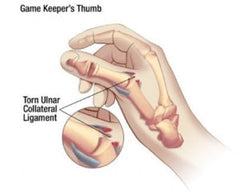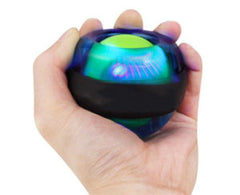Please Let Us Know If You Enjoyed This Article.
Your Feedback Is Important To Us
How different would your daily life be if your wrist or forearm felt like it was constantly being stabbed? You would probably notice that you cannot grip a dumbbell, swing a hammer, type or write at work, hold groceries or even a glass of water. Life begins to get complicated very quickly. All of the sudden, the activities that should be easy, are not that easy anymore. Here is some insight into what is causing your pain and a hand full of simple exercises and stretches that can help.
Anatomy & Biomechanics:

Many of the muscles that control the fingers and wrist are found in the forearm. Try holding your arm in front of you and move your fingers. Watch both sides of your forearm and you will be able to see the muscles moving underneath your skin. Now try that while moving your wrist and you will notice similar movement.
The muscles that straighten your fingers and bend your wrist backwards (extension) are called your extensors. Your extensors start near the outside of your elbow and attach to different parts of your wrist and hand on the top of your forearm.
The muscles that curl your wrist and fingers forward are your flexors. Your flexors start near the inside of your elbow and attach to different parts of your wrist and hand on the underside of your forearm.
For the next set of muscles, hold your hand in front of you with your palm facing up. Using your fingers, make a bowl out of your hand. Imagine filling that bowl up with soup and rotate your forearm and wrist to dump it out. This is made possible by your pronator muscles. Rotating back to the starting position requires your supinator muscles.
These muscles, just like every other muscle in your body, can be injured. Golfer’s elbow, tennis elbow, carpal tunnel and gamer’s/smartphone thumb are very common injuries that effect everything from the elbow to the fingers. These are most often due to being used too much, or with poor technique. The overuse and misuse can lead to muscle spasms, strains, and even tendonitis.
4 Common Injuries:
1. Golfer’s Elbow
Think about the motion of your wrist when you are swinging a golf club. You will notice your dominant wrist curling forward as you make contact with the ball. Doing this over and over can cause your flexors to spasm which over time inflames the tendon. The most intense pain is usually found around the inside of your elbow.
2. Tennis Elbow
This is called tennis elbow because it can be injured with the back-hand motion used while playing tennis. It’s essentially tendonitis involving your extensor muscles. As your extensors are being used too much or at an intensity that they are not ready for, the muscles can spasm and the tendon can become inflamed. The most intense pain is usually found around the outside of your elbow.
3. Carpal Tunnel
On the palm side of your wrist, there is a tunnel called the carpal tunnel. The median nerve, different tendons, and ligaments pass through this tunnel and go to different parts of the hand. When these structures are injured or inflamed, it puts pressure on the median nerve. This can result in pain throughout the hand & wrist, numbness in your fingers, and sometimes weakness throughout your entire hand.

4. Gamer’s & Smartphone Thumb
Yes, these are real injuries, however, it may be hard to believe until you experience it personally. Simply put, this is tendonitis of the thumb. When it happens, it may feel like you have a knife stabbing you in the base of your thumb. Limit your gaming or smartphone use to prevent the injury or for pain relief. It is also good to note that if you have small hands, then an especially large phone will require you to reach further, causing even more stress to your thumb.
Exercises & Stretches:

1. Wrist Curls
Using bodyweight or a very light dumbbell, place your forearm on the edge of a surface. Curl the weight up just like you would for a biceps curl. Then put the other side of your forearm on the surface to exercise the other set of forearm muscles.
2. Hand Squeezes
Using a stress ball or a rehab version of it, squeeze the ball. Hold that position for a few seconds, and then slowly release. This can also be done with squeeze grip hand exercisers, which closely resemble the clamp that goes on a barbell to hold the weight on.
3. Flex Bar Twists
This is commonly used for forearm rehabilitation. Hold the bar with both hands. Keep one hand still and then use the other hand to twist the bar and then slowly return it back to the neutral position. Be sure to twist the bar in both directions.
4. Forearm Supination & Pronation
Using bodyweight, a light dumbbell, or exercise bands, rotate your forearm into the supination (palm up) and pronation (palm down) positions. Start with a few sets of 6-8 reps and gradually progress until you reach 2 sets of 15. If you can accomplish this, then you can increase the resistance and start the process over.
5. Gyro Ball

This is a handy device that involves a spinning ball inside of a casing. As you make circles with your wrist while gripping it, you will notice your wrist having to work harder to keep it under control. Be sure to do circles in both directions.
6. Wrist Wall Stretch
Place the palm of your wrist on the wall and gently bend your wrist backwards. This will stretch your forearm flexors. Flip your hand over so that the back of your hand is on the wall to stretch your extensors. To increase the stretch, try moving your hand up or down the wall and rotate your hand into different positions. You may notice a stronger stretch to the parts of the muscle that need it most. Hold this stretch for about 15 seconds.
7. Thumb Stretch
Make a fist with your fingers wrapped around your thumb. From there, bend your wrist to create a straight line from your forearm to your thumb (ulnar deviation). Hold the stretch for about 15 seconds.
3 Home Treatment Options:
1. Warm-up
Whether you are exercising, working construction, or working at a desk, it is a good idea to warm-up your hands prior––this will prepare your muscles for the demand you are about to place on them. Take a few minutes to move your fingers, wrists, and forearms so that you can bring blood to the area. This will improve the circulation and elasticity of your muscles, making them more efficient, and less likely to be injured.
2. Ice
Try applying ice if you are noticing pain, achiness, or soreness. Alternating 10-15 minutes on, and 10-15 minutes off for 1-2 hours should be enough to provide relief and decrease inflammation. Make sure you progress through the cold, burning, aching, and numb stages to maximizing the benefits.
3. Sports Massage/Trigger Point Therapy
Since muscles are big contributors to these injuries, different muscle work techniques can be helpful. In most cases, getting these injured muscles worked on will be mildly to moderately painful. If it is pleasant or relaxing, then they may be going too easy on you. An experienced sports chiropractor, physical therapist, or massage therapist should know the right amount of pressure to put on the muscle to get you better. You can also try rolling out the muscles of your forearm with a golf ball. Simply pin a golf ball between your forearm and the wall or table and slowly roll it across the muscles.
Conclusion:
I have seen patients quit their careers and drop their hobbies because of these injuries. I have also seen those same patients revive their careers and hobbies after implementing the right treatment, rehab, and prevention routine. These injuries do not have to cause such a negative impact on your daily life! Warm-up, exercise and stretch your forearms and wrists just like any other muscle in your body. See your doctor if you notice tightness, achiness, numbness, or pain that seems to linger or even get worse. There are many conservative and non-surgical options that can help as well. The faster you take action, the better your prognosis will be.
Please Let Us Know If You Enjoyed This Article.
Your Feedback Is Important To Us
Disclaimer: This content is for informational purposes only and is not meant as medical advice, nor is it to diagnose or treat any medical condition. Please consult your physician before starting or changing your diet or exercise program. Any use of this information is at the sole discretion and responsibility of the user.







